RBSE Solutions for Class 7 Maths Chapter 11 Perimeter and Area Intext Questions
Rajasthan Board RBSE Solutions for Class 7 Maths Chapter 11 Perimeter and Area Intext Questions Textbook Exercise Questions and Answers.
RBSE Class 7 Maths Solutions Chapter 11 Perimeter and Area Intext Questions
(Try These Page No: 205)
Question 1.
What would you need to find area or perimeter to answer the following?
1. How much space does a blackboard occupy?
Answer:
Area of blackboard.
2. What is the length of a wire required to fence a rectangular flower bed?
Answer:
Perimeter of flower bed.

3. What distance would you cover by taking two rounds of a triangular park?
Answer:
2 × Perimeter of park.
4. How much plastic sheet do you need to cover a rectangular swimming pool?
Answer:
Area of swimming pool.
(Try These Page No: 206)
Question 1.
Experiment with several such shapes and cut-outs. You might find it useful to draw these shapes on squared sheets and compute their areas and perimeters.
You have seen that increase in perimeter does not mean that area will also increase.
Answer:
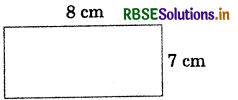
Perimeter = 30 cm
Area = 56 cm2

From the above calculation of area and perimeter we find that increase of perimeter does not lead to increase in area.
Question 2.
Give two examples where the area increase as the perimeter increases.
Answer:
(i)
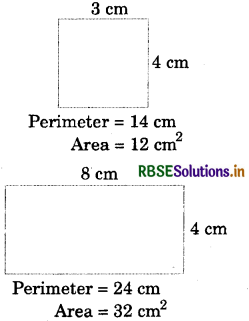

(ii)
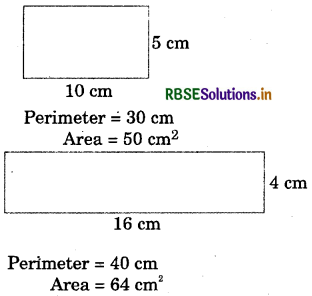
Question 3.
Give two examples where the area does not increase when perimeter increases.
Answer:
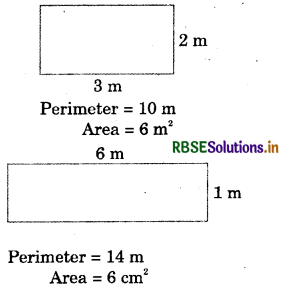

(Try These Page No: 210)
Question 1.
Each of the following rectangles of length 6 cm and breadth 4 cm is composed of congruent polygons. Find the area of each polygon.
Answer:
Area of all rectangles = l × b = 6 × 4 cm2 = 24 cm2. Since, area of all congruent polygon are equal to each other.
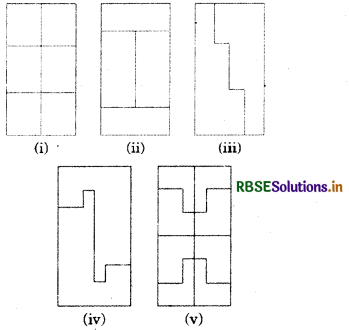
(i) Area of each polygon = (24 ÷ 6) cm2
= 4 cm2
(ii) Area of each polygon = (24 ÷ 4) cm2
= 6 cm2
(iii) Area of each polygon = (24 ÷ 2) cm2
= 12 cm2
(iv) Area of each polygon = (24 ÷ 2) cm2
= 12 cm2
(v) Area of each polygon = (24 ÷ 8) cm2
= 3 cm2

(Try These Page No: 212)
Question 1.
Find the area of following parallelograms:
(i)
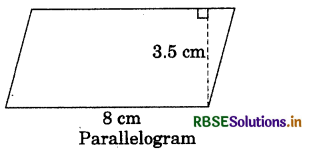
(ii)
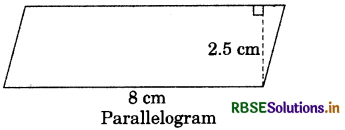
(iii) In parallelogram ABCD, AB 7.2 cm and the perpendicu1ar from C on AB is 4.5 cm.
Answer:
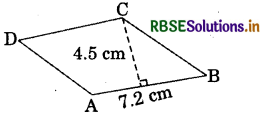
(i) Area of ||gm = base × height
= 8 × 3.5 = 28 cm2
(ii) Area of ||gm = base × height
= 8 × 2.5 = 20 cm2
(iii) Base = 7.2 cm, height = 4.5 cm,
∴ Area of the parallelogram ABCD
= base × height = 7.2 × 4.5 = 32.40 cm2
(Try These: Page No: 219)
Question 1.
(a) Which square has the larger perimeter (in fig.)?
(b) Which is larger, perimeter of smaller square or the circumference of the circle (in fig.)?
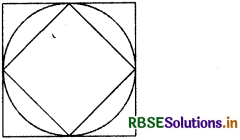
Answer:
(a) The outer square has the larger perimeter.
(b) The circumference of the circle is larger than the perimeter of smaller square.

(Try These: Page No: 222)
Question 1.
Draw circles of different radii on a graph paper. Find the area by counting the number of squares. Also find the area by using the formula. Compare the two values.
Answer:
(i)
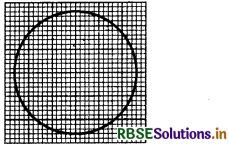
Area by counting the number of squares = 16 cm2
Note:
Count 1 for half or more than half square.
Count 0 for less than half square.
Area by using the formula = \(\frac{22}{7}\) × (2.3)2
= 16.62 cm2
(Area of circle = πr2)
(ii)
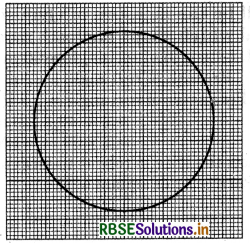
Area by counting the number of squares = 60 cm2
Area by using the formula = \(\frac{22}{7}\) × (4.50)2
= 63.64 cm2
(Area of circle = πr2)
(Try These: Page No: 225)
Question 1.
Convert the following:
(i) 50 cm2 in mm2
Answer:
50 cm2 in mm2
1 cm2 = 1 cm × 1 cm
= 10 mm × 10 mm
= 100 mm2
∴ 50 cm2 = 100 × 50 mm2
= 5000 mm2
(ii) 2 ha in m2
Answer:
2 ha in m2
1 ha = 10000 m2
∴ 2 ha = 10000 × 2 m2
= 20000 m2

(iii) 10 m2 in cm2
Answer:
10 m2 in cm2
1 m2 = 1 m × 1 m
= 100 cm × 100 cm
= 10000 cm2
∴ 10 m2 = 10000 × 10 cm2
= 100000 cm2
(iv) 1000 cm2 in m2
Answer:
1000 cm2 in m2
1 cm2 = \(\frac{1}{10000}\) m2
∴ 1000 cm2 = 1000 × \(\frac{1}{10000}\)
= \(\frac{1}{10}\) = 0.1 m2.
